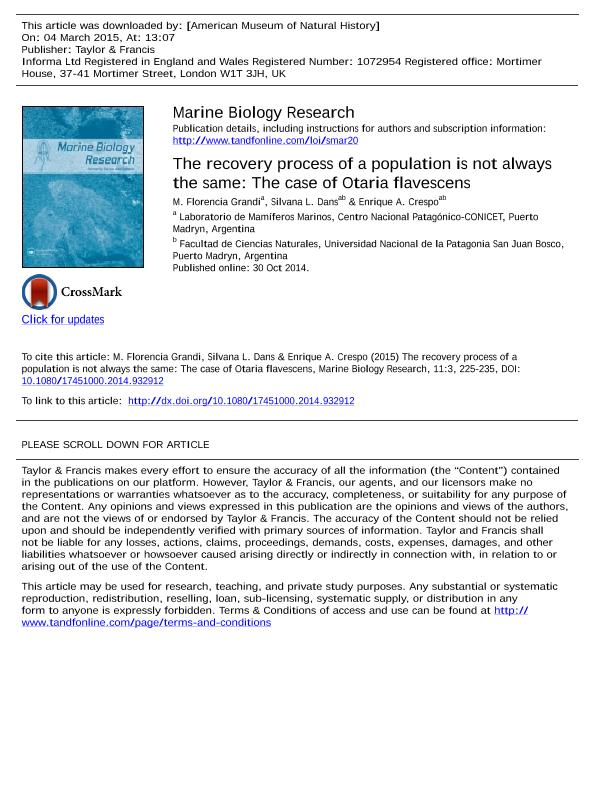Mostrar el registro sencillo del ítem
dc.contributor.author
Grandi, Maria Florencia

dc.contributor.author
Dans, Silvana Laura

dc.contributor.author
Crespo, Enrique Alberto

dc.date.available
2017-08-18T21:43:33Z
dc.date.issued
2015-03
dc.identifier.citation
Grandi, Maria Florencia; Dans, Silvana Laura; Crespo, Enrique Alberto; The recovery process of a population is not always the same: the case of Otaria flavescens; Taylor & Francis As; Marine Biology Research; 11; 3; 3-2015; 225-235
dc.identifier.issn
1745-1000
dc.identifier.uri
http://hdl.handle.net/11336/22728
dc.description.abstract
Populations of the South American sea lion (Otaria flavescens) were decimated throughout its range along the Atlantic coast. Responses to this decline have been different in different parts of the species´ distribution range. Some stocks are still decreasing, some remain stable, and some are recovering slowly. In the Southwestern Atlantic, sea lion populations are now increasing. However, 50 years after the cessation of hunting these populations have not recovered to the levels they had before exploitation, with the recovery process occurring at the same time as increasing development of human coastal activities. The aims of this study were to present recent information on abundance and trends in the southern Patagonian population of sea lions and to test the hypothesis of population expansion with a particular recolonization process. Results showed that there was an increase in the number of sea lions in all colonies and a change in the social composition of nine colonies, but no new breeding colonies were found. The population trajectory of O. flavescens from southern Patagonia was similar to that observed in the rest of the South Atlantic populations, but the recovery and recolonization processes are still in progress. Here we discuss possible explanations of which factors could have delayed the recovery within the Southwestern Atlantic stocks.
dc.format
application/pdf
dc.language.iso
eng
dc.publisher
Taylor & Francis As

dc.rights
info:eu-repo/semantics/openAccess
dc.rights.uri
https://creativecommons.org/licenses/by-nc-sa/2.5/ar/
dc.subject
Abundance
dc.subject
Recolonization Process
dc.subject
South American Sea Lion
dc.subject
Southwestern Atlantic
dc.subject
Trends
dc.subject.classification
Bioquímica y Biología Molecular

dc.subject.classification
Ciencias Biológicas

dc.subject.classification
CIENCIAS NATURALES Y EXACTAS

dc.title
The recovery process of a population is not always the same: the case of Otaria flavescens
dc.type
info:eu-repo/semantics/article
dc.type
info:ar-repo/semantics/artículo
dc.type
info:eu-repo/semantics/publishedVersion
dc.date.updated
2017-07-27T12:33:19Z
dc.identifier.eissn
1745-1019
dc.journal.volume
11
dc.journal.number
3
dc.journal.pagination
225-235
dc.journal.pais
Reino Unido

dc.journal.ciudad
Londres
dc.description.fil
Fil: Grandi, Maria Florencia. Consejo Nacional de Investigaciones Científicas y Técnicas. Centro Científico Tecnológico Conicet - Centro Nacional Patagónico; Argentina
dc.description.fil
Fil: Dans, Silvana Laura. Consejo Nacional de Investigaciones Científicas y Técnicas. Centro Científico Tecnológico Conicet - Centro Nacional Patagónico; Argentina. Universidad Nacional de la Patagonia; Argentina
dc.description.fil
Fil: Crespo, Enrique Alberto. Consejo Nacional de Investigaciones Científicas y Técnicas. Centro Científico Tecnológico Conicet - Centro Nacional Patagónico; Argentina. Universidad Nacional de la Patagonia; Argentina
dc.journal.title
Marine Biology Research

dc.relation.alternativeid
info:eu-repo/semantics/altIdentifier/doi/http://dx.doi.org/10.1080/17451000.2014.932912
dc.relation.alternativeid
info:eu-repo/semantics/altIdentifier/url/http://www.tandfonline.com/doi/abs/10.1080/17451000.2014.932912
Archivos asociados
